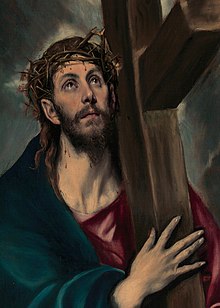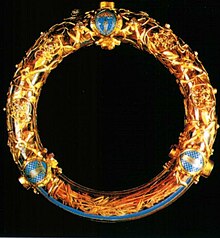
According to the New Testament, a woven crown of thorns (‹See Tfd›Greek: στέφανος ἐξ ἀκανθῶν, translit. stephanos ex akanthōn or ἀκάνθινος στέφανος, akanthinos stephanos) was placed on the head of Jesus during the events leading up to his crucifixion. It was one of the instruments of the Passion, employed by Jesus' captors both to cause him pain and to mock his claim of authority. It is mentioned in the gospels of Matthew (Matthew 27:29),[1] Mark (Mark 15:17)[2] and John (John 19:2, 19:5),[3] and is often alluded to by the early Church Fathers, such as Clement of Alexandria, Origen and others, along with being referenced in the apocryphal Gospel of Peter.[4]

Since at least around the year 400 AD, a relic believed by many[who?] to be the crown of thorns has been venerated. In 1238, the Latin Emperor Baldwin II of Constantinople yielded the relic to French King Louis IX. It was kept in the Notre-Dame Cathedral in Paris until 15 April 2019, when it was rescued from a fire and moved to the Louvre Museum.[6]
Reproductions of the crown are available to tourists from shops in Jerusalem.[7]
- ^ Matthew 27:29
- ^ Mark 15:17
- ^ John 19:2, John 19:5
- ^ Walter Richard (1894). The Gospel According to Peter: A Study. Longmans, Green. p. 7. Retrieved 2022-04-02.
- ^ Davisson, Darrell D (2004). Kleinhenz, Christopher (ed.). Medieval Italy: An Encyclopedia. Vol. 1. Abingdon, England: Routledge. p. 955. ISBN 9780415939294.
- ^ Clicquot, Athénaïs (9 September 2019). "Notre-Dame: la couronne d'épines à nouveau présentée à la vénération des fidèles" (in French). Retrieved 2020-09-15.
- ^ "Carod-Rovira consigue que retiren la bandera española en un acto de la Generalitat en Israel". www.elmundo.es (in European Spanish). 21 May 2005. Retrieved 5 February 2023.
Al salir del Santo Sepulcro, la iglesia de referencia del cristianismo, el 'president' ha fotografiado a Carod-Rovira con una corona de espinas de una tienda para turistas.
[After leaving the Holy Sepulchre, the church of reference for Christianity, the president has photographed Carod-Rovira with a crown of thorns from a tourist shop.]